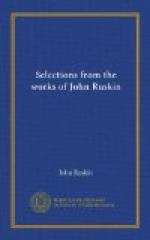It does not belong to my present plan to consider at length the second head of duty of which I have above spoken; the preservation of the architecture we possess: but a few words may be forgiven, as especially necessary in modern times. Neither by the public, nor by those who have the care of public monuments, is the true meaning of the word restoration understood. It means the most total destruction which a building can suffer: a destruction out of which no remnants can be gathered: a destruction accompanied with false description of the thing destroyed. Do not let us deceive ourselves in this important matter; it is impossible, as impossible as to raise the dead, to restore anything that has ever been great or beautiful in architecture. That which I have above insisted upon as the life of the whole, that spirit which is given only by the hand and eye of the workman, never can be recalled. Another spirit may be given by another time, and it is then a new building; but the spirit of the dead workman cannot be summoned up, and commanded to direct other hands, and other thoughts. And as for direct and simple copying, it is palpably impossible. What copying can there be of surfaces that have been worn half an inch down? The whole finish of the work was in the half inch that is gone; if you attempt to restore that finish, you do it conjecturally; if you copy what is left, granting fidelity to be possible (and what care, or watchfulness, or cost can secure it,) how is the new work better than the old? There was yet in the old some life, some mysterious suggestion of what it had been, and of what it had lost; some sweetness in the gentle lines which rain and sun had wrought. There can be none in the brute hardness of the new carving. Look at the animals which I have given in Plate XIV., as an instance of living work, and suppose the markings of the scales and hair once worn away, or the wrinkles of the brows, and who shall ever restore them? The first step to restoration, (I have seen it, and that again and again—seen it on the Baptistery of Pisa, seen it on the Casa d’Oro at Venice, seen it on the Cathedral of Lisieux,) is to dash the old work to pieces; the second is usually to put up the cheapest and basest imitation which can escape detection, but in all cases, however careful, and however laboured, an imitation still, a cold model of such parts as can be modelled, with conjectural supplements; and my experience has as yet furnished me with only one instance, that of the Palais de Justice at Rouen, in which even this, the utmost degree of fidelity which is possible, has been attained, or even attempted.[166]




